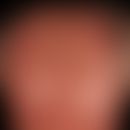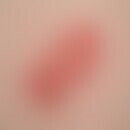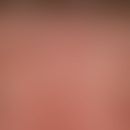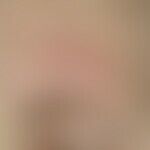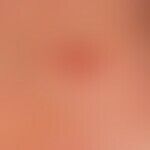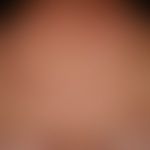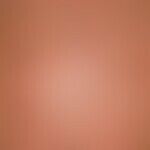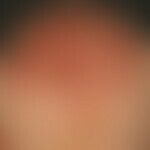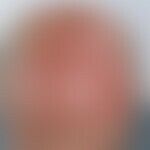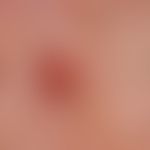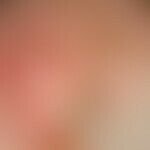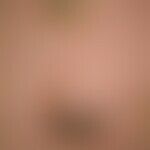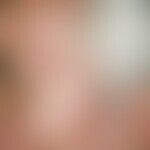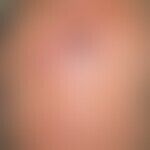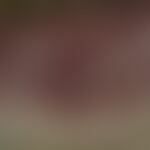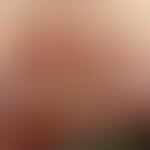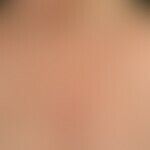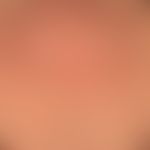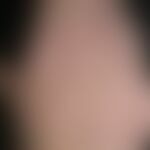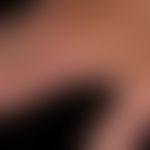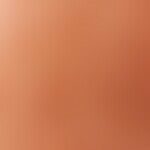Synonym(s)
HistoryThis section has been translated automatically.
DefinitionThis section has been translated automatically.
In fair-skinned, photosensitive individuals, solar damage to the skin resulting from chronic, cumulative exposure to light (duration of exposure > 10 to 60 years), with formation of single or multiple, circumscribed or diffuse, reddish or red-brownish spots, papules, plaques, or nodules. Actinic keratoses (AK) are now defined as noninvasive, early (in situ) squamous cell carcinomas. This view is clarified by new naming conventions such as SCC (squamous cell carcinoma in situ) of the actinic keratosis type or KIN (keratinocytic intraepidermal neoplasia).
You might also be interested in
ClassificationThis section has been translated automatically.
A therapy-relevant clinical classification essentially refers to the extent and number of actinic keratoses (AK):
- Patients with few (<5) AK single lesions.
- patients with multiple (6 and >6) AK lesions
- Patients with field carcinogenesis
- Patients with concurrent immunosuppression
The single lesion can be classified from a clinical point of view as follows:
- Keratosis actinica erythematous type
- Keratosisactinica keratotic type/ cornu cutaneum type
- Keratosis actinica pigmented type
- Keratosis actinica lichenoid type (lichen-planus type)
This classification is a roughly orientating clinical classification. The variants presented can usually be clearly defined and assigned. However, it is not uncommon for mixed types to develop (e.g. formation of an erythematous type with a circumscribed keratotic component).
| Clinical and histological classification of actinic keratoses | |
| Clinic | Histology |
| Erythematous type | Bowenoid type/ Atrophic type |
| Keratotic type/ Cornu-cutaneum type | Hypertrophic type |
| Acantholytic type | |
| Pigmented type | Pigmented type |
| Lichenoid type (Lichen planus type) | Lichenoid type |
Occurrence/EpidemiologyThis section has been translated automatically.
Fair-skinned, red-haired or blond individuals(skin type I/II according to Fitzpatrick) with high chronic sun exposure have a varying risk of developing actinic keratoses, depending on the intensity of the exposed UV rays and age. The number of new cases is estimated at 240,000/year. It is assumed that about 1.7 million people in Germany are currently undergoing dermatological treatment for actinic keratosis (Schaefer 2014).
- Prevalence (Central Europe; in pat. > 40 years): 6-15%.
- Prevalence (USA; in pat. > 40 years): 11-26%.
- Prevalence (Australia; in pat. > 40 years): 45-60%.
- Prevalence (Central Europe; in pat. > 70 years): 52%.
EtiopathogenesisThis section has been translated automatically.
Multiplicative factors (e.g. hair color, positive family history, degree of tan, sun exposure, especially UV rays) play a significant role in the development:
I. Radiations
a) UV ra ys: UVB rays induce so-called signature mutations (pyrimidine dimers) in the basal cell layer. In addition, long-wave UVA rays have an immunosuppressive effect. Carcinogenesis occurs long before the development of visible lesions. In UV-exposed (non-lesional) skin, as the earliest molecular biological correlate of carcinogenesis, key mutations (so-called driver mutations) can be detected in about 25% of all cases. UV radiation leads to point mutations in one of the numerous kinetochore genes, which codes for a kinetochore protein. Kinetochore (Greek kínesis 'movement' and chōros 'site') is the name given to a special plate- or hemispherical-shaped structure of proteins and DNA segments that sits on the side of the centromere and serves as an attachment site for the fibers of the spindle apparatus during nuclear division processes. The upregulation of versch. The upregulation of various kinetochore genes has been demonstrated in various malignant tumors, including actinic keratoses and squamous cell carcinoma of the skin (KNSTRN gene).
UVA radiation leads to decreased expression of the Notch signaling pathway in squamous cell carcinomas. The protein Notch 1 regulates (via p21) numerous cellular processes in keratinocytes such as cell differentiation, proliferation and apoptosis. Deficiency of Notch, as demonstrated in studies of squamous cell carcinomas, promotes their occurrence.
UVB radiation further induces a transition from cytidine to thymidine in the tumor suppressor gene Tp53. This mutation can be detected in > 50% of all AK. P53, when functioning normally, plays an important role in the regulation of cell growth. Loss of function leads to uncontrolled growth of keratinocytes. UVB rays further induce H-Ras mutations. These are detected in 21% of squamous cell carcinomas. The gene product of H-Ras plays an important role in the Erk1/Erk2 signaling pathway. Mutation of H-Ras results in altered Ras protein and increased cell production.
b) X-rays/ionizing radiation
c) Infrared radiation
II. Chemical carcinogens
Chemical carcinogens such as aromatic hydrocarbons (see below MOAH) or arsenic are recognized as full-fledged carcinogens in the induction of cutaneous PEKs.
III Biological carcinogens
HPV: The demonstrated high proportion (> 80%) of oncogenic HPV (human papillomaviruses) in actinic keratoses suggests that HPV may be etiologically relevant in interaction with UV radiation. In actinic keratoses, the prevalence of HPV has been found to range from 40% to 90% in organ transplants vs. 35% to 85% in immunocompetent individuals. HPV types are mostly epidermodysplasia verruciformis types.
IV. Predisposing factors
a) Immunosuppression: >30% of organ transplant patients show at least 5 actinic keratoses, with skin types I/II being preferentially affected. Furthermore, immunosuppressed patients show a more aggressive growth behavior with a more rapid transition into squamous cell carcinoma.
b) Clinical syndromes predisposing to actinic keratoses:
Increased COX-2 (see cyclooxygenases below) and prostaglandin E2 levels have been found in actinic keratoses (see diclofenac below).
ManifestationThis section has been translated automatically.
Occurring mainly in fair-skinned, sunburn-prone and elderly people. Men are affected more frequently than women. Actinic keratoses are the first clinically manifest skin lesions in a UV-damaged skin area, where further lesions can potentially develop. This is referred to as"field carcinization".
LocalizationThis section has been translated automatically.
Chronically light-exposed skin areas of the scalp, especially forehead, bald head, nose, auricles, cheeks, back of the hands, red of the lips (cheilitis actinica). Less frequently: décolleté, extensor side of the forearms, back of the hands, lower legs.
ClinicThis section has been translated automatically.
Keratosis actinica erythematous type: Initially a few millimeters in size, round, oval or irregular, always sharply demarcated, inflammatory red papules or plaques, also interspersed with telangiectasias, with a rough, horny surface. Gradual increase in size (up to 1cm or > 1cm). Bleeding tendency after small injuries.
Incidentlight microscopy reveals yellowish follicular hyperkeratosis, interfollicular erythema, and scaling and white circles around hair follicles.
Keratosis actinica keratotic type/cornu cutaneum type: Papules and plaques with formation of whitish-gray, but also yellowish to brown, or grayish-black horny deposits of varying thickness, often adhering to the base. In the keratotic type, the formation of misshapen, firmly adhering skin horns may occur (see also Cornu cutaneum).
Pigmented type: Actinic keratoses with a brownish tinge due to increased pigment formation, with a tendency to spreading growth.
Lichenoid type (lichen planus type - related to the erythematous type): Clinically, 0.2-2.0 cm large, but also larger, saturated red spots, papules or plaques with shiny, smooth or rough surface are found. Histologically, there are features of lichen planus with acanthosis, hypergranulosis and orthohyperkeratosis as well as subepithelial band-like lichenoid round cell infiltrate.
Clinically, the degree of expression is defined according to Olsen (grades I-III) (see below Keratosis actinica clinical classification). A well-evaluated "scoring" index for quantitative and qualitative assessment of actinic keratoses on the head is the AKASI (acronym for "actinic keratosis area and severity index") (Dirschka T et al. 2017).
Irritated actinic keratoses: This phenomenon can be observed about 1 week after the start of cytostatic therapy, e.g. with 5-fluouracil, and is accompanied by redness, swelling and scaling, apparently as a sign of a cytotoxic effect(cytostatic drugs).
HistologyThis section has been translated automatically.
The histological picture is characterized by hyperkeratosis and parakeratosis on acanthotic widened or atrophic epithelium. Atypical pleomorphic keratinocytes are scattered over the epithelial band. Displaced nuclear-plasma relation, increased mitosis. Single cell dyskeratoses are always detectable, characterized by an amorphous, eosinophilic cytoplasm with a pynotic or missing nucleus. Rarely suprabasal acantholysis. Partially inflammatory infiltrate. Invasivity (i.e. invasion into the papillary body) is not present in actinic keratosis (by definition). An important differential diagnostic criterion for actinic keratosis (differentiation from Bowen's disease) is the absence of the acral adnexal structures (infundibulum, acrosyringium). The excretory ducts wind their way through the altered surface epithelium like a road.
Hypertrophic actinic keratosis: acanthosis, slight papillomatosis, strikingly emphasized hyper- and parakeratosis. Hyperkeratosis can lead to a grotesque disproportion between epithelial thickness and horny layer. This histological finding is consistent with the clinical findings of the cornu cutaneum.
Atrophic actinic keratosis: flat atrophic epithelial band with loss of the reteleal strips; slight hyperkeratosis; cell atypia mostly in the lower third of the epithelium. Here focal bulges towards the dermis. No invasiveness!
Bowenoid actinic keratosis: Hyperkeratosis and parakeratosis on acanthotic dilated epithelium. Atypical pleomorphic keratinocytes are scattered over the epithelial ligament in dense seeding. In addition, epithelial giant cells as well as numerous, bizarre mitoses and dyskeratoses show up. The differentiation from Bowen's disease is based on the detection of the uninvolved adnexal structures.
Acantholytic actinic keratosis: In addition to the typical picture of actinic keratosis a suprabasal acantholysis is observed.
Pigmented actinic keratosis: In addition to the epithelial changes of the AK, there is a simultaneous proliferation of melanocytes and an increased pigment accumulation in the basal keratinocytes.
Lichenoid actinic keratosis: Mostly picture of atrophic actinic keratosis with accompanying distinct lichenoid (band-shaped) infiltrate in the upper dermis. Often numerous dyskeratoses.
Regarding the histological classification according to the degree of dysplasia (KIN I-III) see below CHIN.
Differential diagnosisThis section has been translated automatically.
Clinical:
- Verruca seborrhoica: rather dull surface texture, usually uniform pigmentation. No rough keratoses of the surface
- Arsenic keratoses: nowadays only rarely encountered special form (mostly palmoplantar localized) of actinic keratosis.
- Lupus erythematosus chronicus discoides: marginal red, scaly plaques. Anamnestically, the signs of chronic UV damage are absent.
- M. Bowen: usually solitary plaque; clinically difficult to differentiate.
- Basal cell carcinoma: marginal, gray-glossy plaque, more prominent when the huat is stretched.
- Lentigo solarismaligna: nonpalpable rounded spot, smooth surface structure, color dark brown to blackish brown.
Histologic:
- Verruca seborrhoica: errant forms of verruca seborhhoica. Not always easily distinguishable due to the Borst-Jadassohn phenomenon. However, it lacks the broad-based cell polymorphism of actinic keratosis.
- Lentigo maligna: Lentigo maligna lacks the marked polymorphism of keratinocytes. Irregular proliferation of atypical melanocytes interspersing the epithelial ligament. This phenomenon is absent in actinic keratosis.
- Superficial basal cell carcinoma: more circumscribed basaloid epithelial proliferates separated from the normal epithelium. Wide clefts to surrounding connective tissue.
- Porokeratosis actinic: columnar parakeratotic cones are typical; dyskeratotic cells below the parakeratosis, which are otherwise rather absent.
External therapyThis section has been translated automatically.
| Curettage | 1x, repeat up to 2x |
| Cryotherapy | 1x, multiple repetitions possible |
| Carbon dioxide (CO2) laser | 1x, several repetitions possible |
| Er:YAG laser | 1x, several repetitions possible |
| 5-FU (0.5%)+ SA(10%) | 1x daily for 6-12 weeks |
| 5-ALA-PDT | i.A. 1.0h incubation time |
| MAL-PDT | i.A. 2,5h incubation time |
| Diclofenac-(3%) in 2,5% hyaluronic acid | 2x/day for 60-90 days |
| 5-FU (5%) | 1x or 2x/day for 2-4 weeks |
| Imiquimod (3.75%) | 1x/day for 2 weeks, then 14 days break (1 or 2 cycles) |
Alternative: 5-Fluorouracil in combination with salicylic acid and DMSO (Actikerall®). 1 g of the solution contains 5 mg fluorouracil, 100 mg salicylic acid and 80 mg dimethyl sulfoxide. This combination preparation is used for flat or moderately thickened actinic keratoses. The colorless varnish is applied 1x/day strictly lesionally until complete healing. Multiple actinic keratoses (up to 10 lesions) can be treated simultaneously. Empirical data are available on this. The total area of skin to be treated with Actikerall should not exceed 25 sq. cm (5 cm x 5 cm). (See also no. 757 GOÄ).
Alternative: 5-fluorouracil (as monotherapy): For multiple areal actinic keratoses, local treatment with an ointment containing 5% 5-fluorouracil (e.g. Efudix®) is possible. For monotherapy, apply the 5-fluorouracil ointment 1-2 times/day, duration of treatment 3-6 weeks. The area to be treated must be < 500 qcm. If combined with curettage: Immediately after curettage, apply 5-fluorouracil ointment in a thick layer to the curetted lesion; renew every 2nd day. For lesions < 1 cm, 5-fluorouracil patch every 2-3 days.
Caveat. When using 5-fluorouracil, inform the patient about the method of application and NW! Eye protection!
Alternative combination: 5-fluorouracil + retinoids: In case of multiple areal extension, good results are also reported with a 5% 5-fluorouracil ointment in combination with isotretinoin (e.g. isotretinoin-ratiopharm; Isoderm). Apply 5% 5-fluorouracil (e.g., Efudix ointment) 2 times/day, isotretinoin 10-20 mg/day p.o., duration of therapy 3-5 weeks. Strong inflammatory reactions are to be expected, if necessary apply glucocorticoid-containing creams such as 0.25% prednicarbate (e.g. Dermatop cream) in the meantime, in case of superinfection systemic antibiosis.
Alternative: Imiquimod (Aldara® 5%, Zyclara®3.5%) Topical immunomodulation with 5% imiquimod 1-3 times/week for a total of 8-16 weeks (USA: 2 times/week for 16 weeks). Local inflammation of actinic keratosis occurs, not healthy skin. If irritation is too severe, reduce application frequency to 2 times/week. The success of this therapy has been proven by numerous studies, the cure rate is 40-50%. The therapy is approved in Germany. For Aldara there is a therapy limit of 25qcm treatment area. For Zyclara no limitation.
Alternative: Photodynamic therapy. For single lesions, patch photodynamic therapy (Alacare® for up to 6 single lesions) is a good alternative.
Alternative: Photodynamic daylight therapy: Also suitable for single-cell lesions is photodynamic daylight therapywith methyl-ALA. Methyl-ALA (Luxerm®) accumulates in the tumor cells, is converted to the photosensitizer protoporphyrin IX, which is effective under daylight (application advantage for the patient !).
Externals in field cancerization:
Diclofenac: Very good results were obtained with the local, well-tolerated application of a 3% diclofenac gel(Solaraze®, 2 times/day; Solacutan ®). No limitation of the treatment area! Inhibition of the arachidonic acid cycle leads to induction of apoptosis and suppression of angiogenesis. Remission rates of 40% in clinically visible lesions are reported in the literature.
Alternatively, external retinoids such as 0.3% adapalene gel and tazarotene gel have also been shown to be effective in various clinical studies (off-label use). External skin irritations have to be considered, especially in long-term therapy.
Alternative: photodynamic therapy. In case of field cancerization, local photosensitization with 20% delta-aminolevulinic acid (ALA) and subsequent irradiation with infrared light is suitable.
Alternative: photosensitization with methyl ALA and irradiation with Aktilite®.
Alternative: Tirbanibulin (Klisyri) as selective antiproliferative microtubule inhibitor in mild actinic keratoses once daily for a total of 5 days. Reevaluation should be done after 8 weeks.
Operative therapieThis section has been translated automatically.
For the lesion-directed therapy procedures listed below, it is generally recommended to arrange for a meaningful histological examination of the scraped material.
- Lesion-directed curettage: After prior local anesthesia for isolated actinic keratoses, curettage of the lesion with a flat sharp curette. Actinic keratoses usually detach easily in toto. Histological examination of the scraped material is useful.
- Lesion-directed laser therapy with ablative laser (e.g., erbium YAG laser) have a very good response rate. Ablative laser treatment with an Er:YAG laser showed a nearly 90% healing rate. It is recommended to take curettage material immediately before laser treatment for histological confirmation of the findings.
- Lesion-directed electrocautery with a ball: Pass the ball over the lesion with a weak current and delicately curette with a curette.
- Lesion-directed cryosurgery with cotton swab: Especially in case of several smaller foci, this treatment is a good alternative to curettage. Immerse cotton swab in liquid nitrogen, press on the lesion continuously for 5-10 sec.
- Lesion-directed cryosurgery in an open spray procedure: For large-area actinic keratoses with or without local anesthesia. Spray lesion briefly so that the area is covered with a white layer of ice. If necessary, repeat the procedure after thawing the lesion. Protect surrounding skin by moulage (e.g., perilesional application of a thick layer of Vaseline).
Progression/forecastThis section has been translated automatically.
The guidelines (Stockfleth 2016) assume a low (0-7.2%) probability of complete spontaneous regression.
The data on the development of squamous cell carcinomas on the basis of actinic keratoses (AK) vary considerably. They are indicated with 0.1%- 20%. A higher risk can be expected if > 5 AKs are present. In this clientele, the total risk of developing an invasive squamous cell carcinoma within 10 years is assumed to be 6.1-10% (Hommel 2016).
How does the progression of AK into squamous cell carcinoma proceed? It was assumed that an increasing intraepidermal stratification disorder of AK leads to squamous cell carcinoma. First, pleomorphic keratinocytes develop in the lower third of the epidermis (CHIN I) before they also penetrate higher epidermal layers (CHIN II/III). Only then would infiltrating growth occur. This formalistic progression model, however, does not adequately map the transformation of AK into an invasive squamous cell carcinoma, as invasiveness can develop from any KIN stage (Fernandez-Figueras 2015).
ProphylaxisThis section has been translated automatically.
Avoidance of stronger sun exposure by textile, chemical (e.g. Daylong actinica) and physical light protection measures as well as regular preventive check-ups.
Recent studies (Chen AC 2015) indicate that the intake of vitamin B3 (2x 500mg) has a UV-protective effect. The formation of new actinic keratoses is significantly reduced.
There is good individual experience with the topical use of photolyases, if necessary in combination with a light protection preparation (Eryfotona ®) for mild actinic keratoses.
Avoidance of photosensitizing or phototoxic medicaments, e.g. hydrochlorothiazide
Practical tipsThis section has been translated automatically.
GOÄ Tips:
Treatment includes no. 1 GOÄ (consultation), no. 7 GOÄ (examination of skin organ), 750 GOÄ (dermoscopy), if necessary video dermoscopy (no. 612 GOÄ analogue).
No. 612 GOÄ analogue and No. 750 GOÄ are to be applied next to each other if they refer to different skin changes. (750 for melanocytic nevus, 612 analogue for actinic keratosis).
No. 744 GOÄ (80 points) is used for a skin punch. The number is to be charged only once.
No. 303 GOÄ concerns a test biopsy with a needle, e.g. 2mm punch biopsy which is not sutured (80 points). It can be billed several times (e.g. for the evaluation of a marginal infiltration of a tumorous lesion - sclerodermiform basal cell carcinoma).
No. 2401 GOÄ (133 points) concerns a sample biopsy. The number defines an excision. If necessary, it can be billed several times.
No. 2403 GOÄ concerns the therapeutic excision of a small tumour (up to the size of a cherry stone). The number can be charged more than once
No. 2404 GOÄ concerns the therapeutic excision of a larger tumour (from the size of a cherry stone). Remark: On head and hands every finding is considered as large (Lit Haut 03/16). The figure can be applied more than once.
Further therapeutic services:
No. 745 GOÄ (wart removal with sharp spoon) can be applied analogously for a curettage.
No. 746 GOÄ (electrolysis) can be applied as electrodissection, also in addition to No. 745 GOÄ analogously.
No. 757 GOÄ chemosurgical treatment of a precancerous lesion, e.g. with fluorouracil, can be charged only once for one lesion, even in the case of several sessions. No. 757 can be charged several times for several lesions.
Laser treatments of an actinic keratosis: according to the recommendations of the German Medical Association (BÄK of 2002, supplement and specification for actinic keratoses in the DÄB of 27.12.2010) the following numbers are to be charged:
- No. 2440 GOÄ analog (surgical removal of a nevus flammeus)
- alternatively no. 2885 GOÄ analog (removal of a small blood vessel tumour)
- alternatively no. 2886 GOÄ analog. (Removal of a large blood vessel tumour)
- No. 444 GOÄ: (surcharge for outpatient performance of surgical services rated at 800-1199). The approach is justified (Lit Haut 03/16) is however often disputed.
The recommendations for laser ablation listed here correlate with the S1-guideline of the Arbeitsgemeinschaft der Wissenschaftlichen Medizinischen Fachgesellschaften (AWMF) for the treatment of actinic keratoses, which was lead-managed by the Deutsche Dermatologische Gesellschaft (German Dermatological Society). According to this guideline, ablative laser treatment of actinic keratoses is a highly effective therapy option, with described complete remissions of 90-91%. This high complete remission rate particularly justifies this therapeutic approach, which takes into account the clinically not always noticeable transition of actinic keratosis into an invasive growing squamous cell carcinoma.
Photodynamic therapy of actinic keratosis: to be applied according to the recommendations of the German Medical Association (DÄB of 18.1.2002) are the following numbers:
- NR: 5442 GOÄ(static renal scintigraphy) analogous as photodynamic diagnostics
- No. 566 GOÄ (phototherapy of a newborn) analogously as photodynamic light irradiation, up to 2 x in the treatment case.
- No. 5800 GOÄ (preparation of a radiation plan) analogously as radiation plan for photodynamic therapy. The number is to be applied once per treatment case.
- No. 5802 GOÄ (orthovoltage irradiation per fraction). This figure is used as a supplementary figure in addition to No. 566 GOÄ for 2 further irradiation fields.
- No. 5803 GOÄ (supplement to No. 5802) analogous . This figure is applied as a supplementary figure in addition to no. 566 GOÄ for each additional irradiation field.
- No. 209 GOÄ: Application of the photosensitizer
- No. 200 GOÄ: Application of the occlusive tape
- No. 530 GOÄ: Application of a cold pack.
- No. 745 GOÄ. In case of pre-treatment of a lesion, the figure for curettage can be applied.
LiteratureThis section has been translated automatically.
- Ackerman AB et al (2006) Solar (actinic) keratosis is squamous cell carcinoma. Br J Dermatol 155: 9-22
- Braakhuis BJ et al (2003) A genetic explanation of Slaughter's concept of field cancerization: evidence and clinical implications. Cancer Res 63: 1727-1730
- Chen AC et al (2015) A phase 3 randomized trial of nicotinamide for skin cancer chemoprevention. N Engl J Med 373:1618-1626.
- Dirschka T et al. (2017) A proposed scoring system for assessing the severity of actinic keratosis on the head: actinic keratosis area and severity index. J Eur Acad Dermatol Venereol 31:1295-1302
- Dubreuilh WA (1896) Des hyperkeratoses circonscrites. Ann Dermatol Venereol 27: 1158-1164
- Fernández-Figueras MT et al.(2015)Actinic keratosis with atypical basal cells (AK I) is the most common lesion
- associated with invasive squamous cell carcinoma of the skin. J Eur Acad Dermatol Venereol 29:991-997.
- Freudenthal W (1926) Verruca senilis and keratoma senile. Arch Dermatol Syphilol (Berlin) 158: 539-544.
- Fritsch C, Ruzicka Th (2003) Fluorescence diagnosis and photodynamic therapy of skin diseases. Atlas and handbook. Springer, Heidelberg Berlin
- Hengge UR, Stark R (2001) Topical imiquimod to treat intraepidermal carcinoma. Arch Dermatol 137: 709-711
- Hommel T et al (2016) Actinic keratoses. Dermatol 67: 867-875
- Kang S et al (2003) Assessment of adapalene gel for the treatment of actinic keratosis and lentigines: A randomized trial. J Am Acad Dermatol 49: 83-90
- Nakaseko H et al (2003) Histological changes and involvement of apoptosis after photodynamic therapy for actinic keratoses. Br J Dermatol 148: 122-127
- Nicolas M et al (2003) Notch1 functions as a tumor suppressor in mouse skin. Nat Genet 33:416-421.
- Röwert-Huber J et al (2007) Actinic keratosis is an early in situ squamous cell carcinoma: a proposal for reclassification. Br J Dermatol 156 (Suppl 3) 8-12
- Schaefer I et al. (2014) Prevalence and risk factors of actinic keratoses in Germany--analysis of multisource data. J Eur Acad Dermatol Venereol 28:309-313.
- Stege H et al. (2017) New approaches to the prevention of actinic keratoses. Dermatologist 68: 354-358
- Stockfleth E et al. (2004) Low incidence of new actinic keratoses after topical 5% imiquimod cream treatment: a long-term follow-up study. Arch Dermatol 140: 1542
- Werner RN et al. (2015) Evidence- and consensus-based (S3) Guidelines for the Treatment of Actinic
- Keratosis - International League of Dermatological Societies in cooperation with the European Dermatology Forum - Short version. J Eur Acad Dermatol Venereol 29: 2069-2079.
- Wolf JE et al. (2001) Topical 3% diclofenac in 2.5% hyaluronan gel in the treatment of actinic keratoses. Int J Dermatol 40: 709-713
- Zeicher J et al. (2009) Placebo-controlled, double-blind, randomized pilot study of imiquimod 5% cream applied once per week for 6 months for the treatment of actinic keratoses. JAAD 60: 59-62
Incoming links (63)
Actinic keratosis; Albinism oculocutaneous tyrosinase-negative; Apoptosis; Bowen's carcinoma; Bowen's disease; Carcinogenesis; Carcinoma in situ; Chondrodermatitis nodularis chronica helicis; Classification of actinic keratoses; Colchici semen; ... Show allOutgoing links (55)
Adapalen; Albinism (overview); Arsenic keratoses; Basal cell carcinoma (overview); Basal cell carcinoma superficial; Bloom syndrome; Borst-jadassohn phenomenon; Bowen's disease; Cauterization; Classification of actinic keratoses; ... Show allDisclaimer
Please ask your physician for a reliable diagnosis. This website is only meant as a reference.

